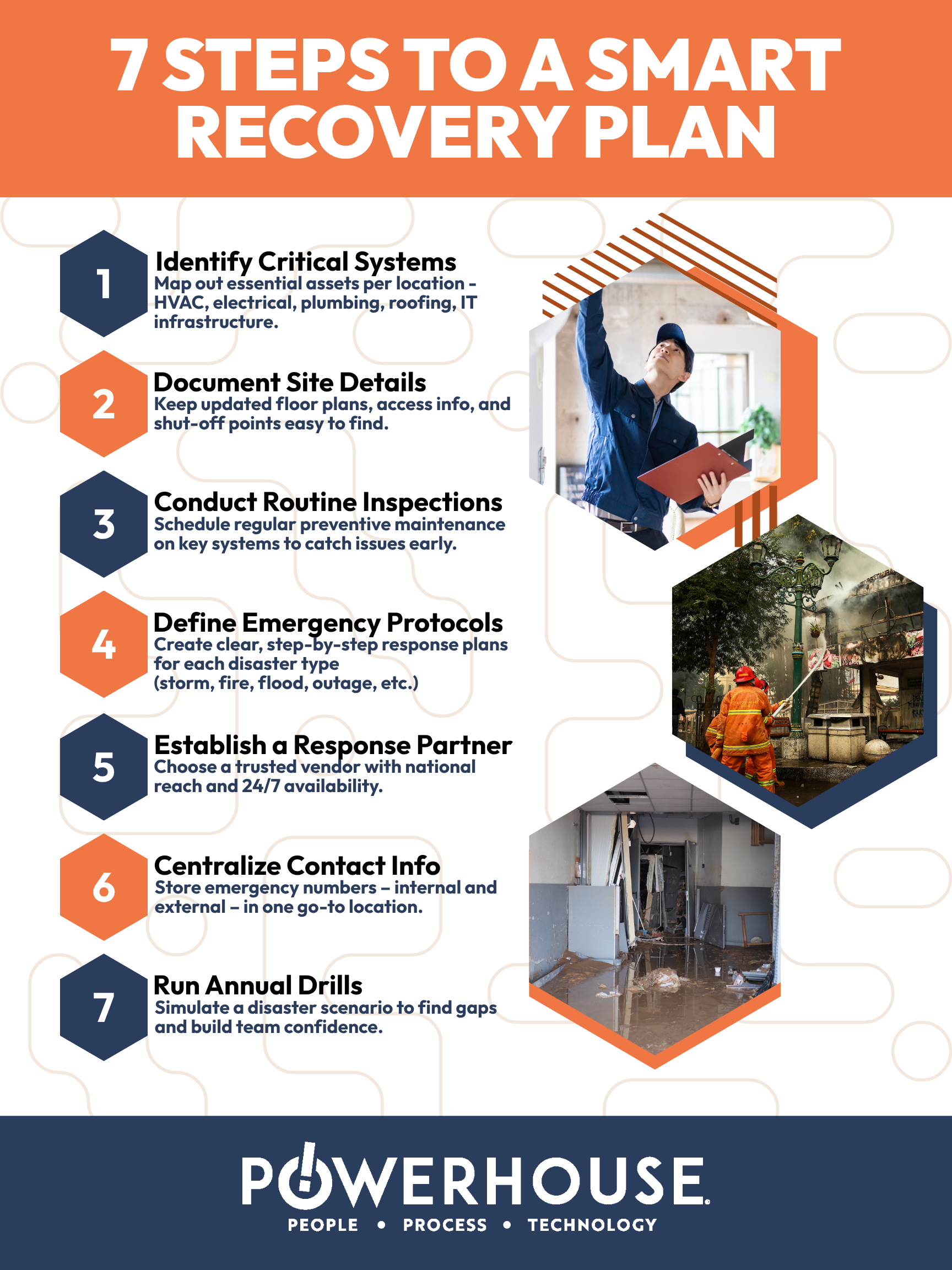When Disaster Strikes: How Multi-Site Facilities Can Bounce Back Fast
When Disaster Strikes:
How Multi-Site Facilities Can Bounce Back Fast
The Unexpected Hits. PHFM Responds.

Summer brings more than just hot temperatures – it marks the height of disaster season for facilities across the nation. From hurricanes and flash floods to extreme heat and sudden power outages, the threat of disruption is widespread. For multi-site operators, these aren’t isolated incidents – they’re high-impact events that compromise entire networks and bring operations to a halt.
In today’s fast-moving environment, recovery isn’t only about repairs. It’s about how quickly and seamlessly you can bounce back. As facilities leaders look to protect uptime, reduce risk, and keep service continuity, having a proactive disaster recovery strategy is more critical than ever.
The Hidden Cost of Downtime
When a crisis hits, delays don’t just create bottlenecks – they ripple through your business. Extended closures, safety concerns, unhappy tenants, and costly asset damage can pile up fast, adding significant financial stress. For smaller businesses, these losses can range from $137 to $427 per minute, while larger operations can face hits of $5,600 to $9,000 every minute. With impacts this severe, speed and coordination become critical when disaster strikes. And for teams juggling several locations, the pressure is even higher. Coordinating vendors, managing repairs, and restoring order across sites can overwhelm even the most seasoned crews.
Minimizing downtime is no longer a reactive goal, it’s a proactive priority. By investing in rapid response capabilities and scalable recovery processes, facilities teams can turn potential chaos into controlled, strategic action.
What Fast, Effective Recovery Really Takes
Getting back online quickly doesn’t happen by accident. It takes the right people, process, and technology in place before disaster strikes. Facilities leaders need vetted technicians ready to deploy, not just in one market, but nationwide. They need a single source of truth for updates and decisions, not scattered spreadsheets or endless email chains. And they need real-time visibility into every step of the recovery process to make informed decisions fast.
That’s where our clients lean on Powerhouse. With 24/7 support and our proprietary Infinity platform, they stay in control when it matters most. From the first call to final sign-off, we help facilities leaders restore operations quickly, consistently, and with full transparency.
Infinity offers many benefits for our customers including:
- Real-Time Project Visibility – Monitor progress, technician updates, and job statuses across all your sites in one centralized dashboard.
- Faster Response Times – Streamlined communication = quicker dispatching and issue resolution.
- National Scalability – Manage recovery efforts across dozens (or hundreds) of sites without losing clarity.
- Data-Driven Decisions – Access historical service data and reporting to plan smarter and spot recurring issues.
The Powerhouse Approach to Rapid Recovery
At the end of the day, recovery’s not just about having the right tools – it’s about how you use them. Powerhouse brings a proven, scalable approach that turns setbacks into action. Our teams move fast, coordinate seamlessly across locations, and prioritize minimal downtime from the start.
What really sets us apart? It’s not just coverage – it’s how we simplify the chaos. Whether you’re overseeing five sites or fifty, we handle the behind-the-scenes logistics: contractors, compliance, safety checks – you name it. That frees up your internal team to stay focused on the big picture – while our end-to-end disaster recovery services bring consistency and control across every location. Every time.
Proactive Planning Starts Now
Disaster recovery doesn’t begin with a weather alert. The most resilient facilities teams have their bases covered: they know which system matters most, where the weak points are, and what steps to take before an emergency ever hits.
That includes setting up regular inspections, checking backup power, and documenting key contacts and layouts for every location. And most importantly? It means aligning with a partner who understands your portfolio and can execute across it quickly and consistently. Studies show that 75% of businesses without a continuity plan fail within three years of a disaster – a pressing reminder that what you do before disaster hits determines how well you recover after.
Here’s a simple checklist of steps to help get your sites ready this summer:

Be Ready Before the Next Emergency Hits
Disruptions are inevitable – but getting blindsided doesn’t have to be part of the deal. The difference between prolonged downtime and a smooth recovery often comes down to what you’ve done before the chaos begins.
Disasters don’t wait – and your response plan shouldn’t either. Powerhouse is here to help you turn disruption into a moment of strength.
Ready to protect your facilities and bounce back faster? Let’s build resilience together!
Reposted by PHFM, A Powerhouse Company

